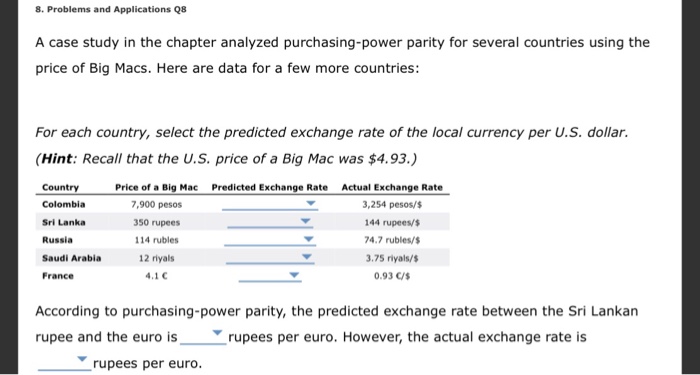
How Much Rupee For Big Mac And Cheese

What is a fair price? This is the age-old question in economics. Water is essential to life, yet its price is nothing compared to diamonds, which are mere ornaments. Surely water is more valuable? Priyanka Chopra, who was feted for playing Mary Kom, earned more in a movie than the real Mary Kom over her lifetime. The acting role has “more value” than the real person’s feat. Beer in America is often cheaper than milk. Which is more nourishing? In the market economy, ultimately it is all about supply and demand. We could argue forever whether this is fair or not, but this is the brutal logic of the market. The value of all things is in terms of money. How do you determine the value of money? How do you know if a currency is fairly valued?
Let’s look at the rupee. How do we know it is fairly valued? By comparing it to other currencies. The exchange rate indicates its value. We know that these days you need Rs 64 to buy $1. In Thailand you need only 34 bahts for a dollar. But in Japan you need 125 yen for a dollar. Does than mean the rupee is half as strong as the Thai baht, and twice as strong as the yen? Of course not. You need to look at the average purchasing power in those countries. We know that those two currencies are “stronger” than the rupee. But exactly how?
For this, we use the Big Mac Index. This was proposed almost 30 years ago by The Economist magazine of London, and has been in vogue ever since. The Big Mac is the most popular hamburger sold at MacDonald’s fast food restaurants, which can be found in most countries across the world, and has tens of thousands of outlets. Let’s say you have $5 in your pocket. If you are in a typical neighbourhood of New York City, you would pay about $4.8 for a Big Mac. Now what if you roamed around the world with that $4.8? In Delhi you would have 4.8 x 64 = Rs 307.2. This can get you almost three Big Macs in Chankaypuri, because one costs only Rs 116. (Actually you will buy Maharaja Macs, since there is no beef-based hamburger at MacDonald’s in India). So the rupee exchange rate is too “cheap”. Or dollar is too “expensive”, ie, not fairly priced. You could do this exercise by roaming around in Tokyo, Bangkok, Moscow, Sao Paolo, Kiev, Karachi or even Timbuktu. The local price of the Big Mac tells you whether currency is undervalued (too cheap) or overvalued (too expensive) as compared to the official exchange rate.
Of course you can quibble. You can say the burger is cheap in India because labour is cheap. The Big Mac price will also be affected by the rentals to be paid (some cities like Mumbai have very high real estate prices). Despite its shortcoming the Big Mac index has been quite a reliable indicator of whether a currency is over or undervalued. In some ways this reliability of the index is connected to the theory of Purchasing
Power Parity, which says that eventually all items that can be traded across borders will achieve price parity. If steel was very cheap in India and expensive in Europe, it would get exported, until the excess supply in Europe drives down its price, and scarcity in India makes it more expensive.
The latest Big Mac index, published this month in The Economist, reveals that the Indian rupee is one of the most undervalued currencies in the world! It needs to be stronger by almost 60 per cent, ie, it should be at 40 not 64. Imagine how cheap will petrol become, but how unhappy Infosys and Wipro (software exporters) would be? Maybe we should have our own Masala Dosa Index!
Disclaimer: The views expressed here are the author's own. The opinions and facts expressed here do not reflect the views of Mirror and Mirror does not assume any responsibility or liability for the same.
Food typically takes 24-72 hours to digest, but the grease and trans fat inside a Big Mac means the digestion time for the McDonald's signature burger can easily go beyond three days. 'If you want to enjoy a Big Mac, try to keep it an occasional event,' is the advice from Fast Food Menu Price. Jun 24, 2016 So the “raw” Big Mac index says that the yuan was undervalued by 46% at that time. Similarly, in India, a Big Mac costs $1.90, which implies that the Rupee is undervalued by 61.4%, thereby indicating that if PPP were the only criterion to determine exchange rates, the Rupee would have an exchange rate of ₹25.76. According to the Big Mac Index, the US Dollar should be worth around Rs.26 or so or say Rs.30/- if we go by what is the considered view of the author Sree Iyer, on his article titled Why the Rupee exchange rate should be 30 to a dollar. As against this, the official exchange rate is around Rs.67/. In other words, the rupee is undervalued. The latest Big Mac index, published this month in The Economist, reveals that the Indian rupee is one of the most undervalued currencies in the world! It needs to be stronger by almost 60 per cent. In real terms, the rupee is actually one of the most undervalued currency in the world. The famous Big Mac index proves this conclusively. Developed by The Economist 25 years ago, the Big Mac index uses the price of McDonald’s burger in different countries to construct an informal (but surprisingly accurate) indicator of real exchange rate.

Pick your favorite and click vote
How Much Rupee For Big Mac Price
